
2. 自然资源部成矿作用与资源评价重点实验室, 中国地质科学院矿产资源研究所, 北京 100037;
3. 油气藏地质及开发工程国家重点实验室, 成都理工大学, 成都 610059
2. MNR Key Laboratory of Metallogeny and Mineral Assessment, Institute of Mineral Resources, Chinese Academy of Geological Sciences, Beijing 100037, China;
3. State Key Laboratory of Oil and Gas Reservoir Geology and Exploitation, Chengdu University of Technology, Chengdu 610059 China
板内洋岛玄武岩(OIB)的最初定义是远离构造板块边界的许多火山岛上发现的玄武岩,并认为这种构造板块内部的玄武岩喷发与板块构造作用没有直接关系(Niu et al., 2011)。自20世纪60年代首次提出地幔柱理论以来,OIB被认为与地幔柱有关(朱弟成等, 2006; 牛耀龄, 2010; 夏瑛等, 2012; Li et al., 2016)。但是近年来除被公认为典型板内地幔柱成因的洋岛型OIB(夏威夷岛链)和大火成岩省型OIB(峨眉山玄武岩)以外,地质学家在许多俯冲带周缘也发现了大量的具有和OIB地球化学性质极为相似的“富集型”基性岩。这些基性岩浆岩被解释为一些特定的俯冲过程的产物(如:洋中脊俯冲和板片断离)(Li et al., 2014b; Liu et al., 2014)。虽然,在上述俯冲过程中,OIB源区物质的来源仍有较大的争论(牛耀龄, 2010),但是对其地球化学性质和成因的研究仍可以有效的帮助我们约束俯冲作用中的相关过程(Faccenna et al., 2010; Zhu et al., 2016)。
狮泉河-纳木错蛇绿岩带是青藏高原西部重要的蛇绿岩带之一,是研究特提斯洋东段演化及青藏高原地体增生和隆升的重要内容(Kapp et al., 2003; 郑有业等, 2006; Zhu et al., 2013; Xu et al., 2014)。前人对于狮泉河-纳木错蛇绿岩带与北侧的班公湖-怒江蛇绿岩带之间的关系仍存在诸多争议(Zhang et al., 2012; Zhu et al., 2013., 2015 ),而对于蛇绿岩本身岩石地球化学及年代学研究是解决这些争议的最为重要的手段。现有的研究多认为狮泉河蛇绿岩为俯冲带上(SSZ)型洋壳残余,其形成通常被认为与班公湖-怒江洋(后简称班-怒洋)壳南向或北向的俯冲作用相关(Kapp et al., 2003, 2007; Liu et al., 2018)。然而,关于狮泉河蛇绿岩带所代表洋壳的时空演化过程仍需要进一步细化。
本文首次报道在狮泉河-纳木错蛇绿岩带中发现的侵位在地幔橄榄岩中的OIB型辉绿岩脉及高镁闪长岩脉。对该OIB型辉绿岩开展了锆石U-Pb年代学,对辉绿岩和闪长岩进行了岩石地球化学的研究工作,讨论其性质、构造环境和成因。研究数据将为理解狮泉河蛇绿岩所代表的洋壳演化历史提供重要依据,并为解决前人争议提供参考。
1 地质背景和样品描述班公湖-怒江缝合带(后简称班-怒带)西起班公湖,向东经改则、安多、索县至丁青,再折而向南沿怒江直下,整体呈东西向展布的“S”型(Yin and Harrison, 2000;Zeng et al., 2016a;Lin et al., 2017;Liu et al., 2018;Song et al., 2018;李世民,2018)。该缝合带为南羌塘地块(北侧)和拉萨地块(南侧)的结合带,记录了班-怒洋的诞生、演变和消亡,是特提斯洋演化和盆山耦合的关键研究区域之一(Kapp et al., 2003; 张玉修, 2007;Hu et al., 2015; Zeng et al., 2016a; Huang et al., 2017; 李世民,2018)。然而,对于洋盆开启的时间、洋盆的演化以及洋壳俯冲的极性等问题仍然存在着争议(Kapp et al., 2003, 2005; Gehrels et al., 2011; Zhu et al., 2013; Li et al., 2014a; Zeng et al., 2016a; 曾敏等, 2017)。
广义上的班-怒带包括位于羌塘地体和拉萨地体之间的由复理石及蛇绿混杂岩所组成的近东西展布的广泛区域(Pearce and Deng, 1988; Kapp et al., 2003, 2005; Zhang and Zeng, 2018),其垂向(南北向)宽度很大(局部>200km),且有至少两条蛇绿岩带在其中断续出现(Girardeau et al., 1985; Kapp et al., 2003; Zhu et al., 2013),而许多研究工作所采用的班-怒带位置实际上为其北界(Kapp et al., 2005; Zhang et al., 2014)。对于这两条蛇绿岩带成因的认识主要存在两种对立观点:1)形成在班-怒带内的蛇绿岩在持续构造挤压过程中向两侧发生逆冲推覆(尤其是向南向拉萨地体内部推覆),多条蛇绿岩带均为源自班-怒带蛇绿岩的逆冲推覆席(Girardeau et al., 1985; Kapp et al., 2003, 2005; 张玉修, 2007);2)存在两条独立的蛇绿岩带,即北侧的班公湖-怒江蛇绿岩带和南侧的狮泉河-纳木错蛇绿岩带,分别代表不同性质的洋盆残余(Zhu et al., 2013; Xu et al., 2014),二者之间主要为班-怒洋俯冲过程中改造或增生而成的新生地壳(“北拉萨地体”)(Zhu et al., 2013, 2016; Xu et al., 2014; Zeng et al., 2018)。尽管存在上述争议,但几乎所有相关研究工作都把两条蛇绿岩带纳入班-怒洋演化的范畴(Kapp et al., 2003, 2005; 张玉修, 2007; Zhang et al., 2012; Zhu et al., 2013; Xu et al., 2014)。对于班-怒洋的演化过程,大部分学者认为其经历了完整的威尔逊旋回,但是旋回各阶段的时限以及性质仍然存在争议(曾敏等, 2017)。因此,对班-怒带蛇绿岩及相关地质体开展进一步的深入研究是解决上述争议的关键,而此争议的解决是厘清班-怒带时空演化过程及蛇绿岩就位机制的关键,对理解与班-怒带相关的其它疑问也有重要意义。
本研究发现的辉绿岩脉位于西藏阿里地区狮泉河噶尔县县城北北西约10km处(图 1;N32°34′42″、E80°03′42″),从构造背景上来说属于狮泉河-纳木错蛇绿岩带(图 1)。辉绿岩脉侵位于狮泉河蛇绿岩带的蛇纹石化橄榄岩中,且已变形成透镜状(图 2a),透镜体形态指示了南北向挤压缩短为主的构造变形。辉绿岩与橄榄岩的接触带可见明显的热接触冷凝边(图 2b),同样表明其侵入接触关系。辉绿岩镜下含少量斜长石斑晶(图 2c),基质主要为斜长石和单斜辉石,基质中斜长石较为自型,具有辉绿结构(图 2d)。副矿物主要有钛铁矿和磁铁矿等。此外,在辉绿岩脉北北东向约200m处发现有同样侵位于地幔橄榄岩中的闪长岩脉(图 1;采样位置坐标为N32°34′56″、E80°03′25″)(图 2e)。闪长岩镜下具斑状结构,斑晶主要为角闪石,基质主要为斜长石、角闪石以及少量的黑云母(图 2f)。
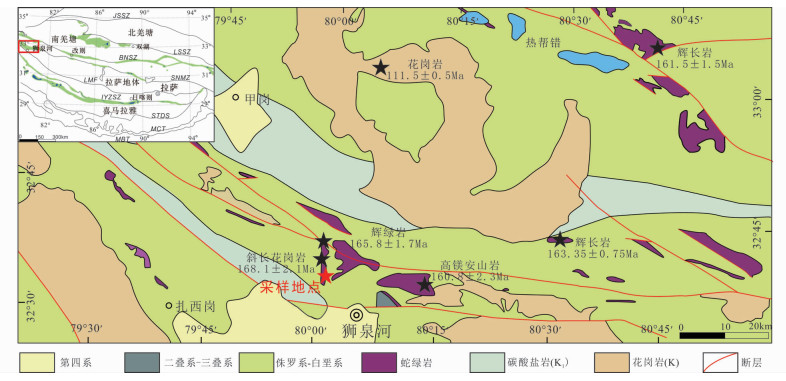
|
图 1 工作区地质简图(据Liu et al., 2018; Zhu et al., 2013) JSSZ=金沙缝合带;LSSZ=龙木错-双湖缝合带;BNSZ=班公湖-怒江缝合带;SNMZ=狮泉河-纳木错蛇绿岩带;LMF=罗巴迪-米拉山断层;IYZSZ=雅鲁藏布江缝合带.红色五角星为本次狮泉河辉绿岩和闪长岩的采样地点; 黑色五角星为研究区周缘可参考的前人年龄数据 Fig. 1 Simplified geologic map of the work area(after Liu et al., 2018; Zhu et al., 2013) JSSZ=Jinsha Suture Zone; LSSZ=Longmu Tso-Shuanghu Suture Zone; BNSZ=Bangong-Nujiang Suture Zone; SNMZ=Shiquanhe-Nam Tso Ophiolitic Mélange Zone; LMF=Luobadui-Milashan Fault; IYZSZ=Indus-Yarlung Zangbo Suture Zone. The red five-pointed star in the picture is the sampling location of the Shiquanhe diabase and diorite in this study; while the black five-pointed star is the predecessor age data for the study area |
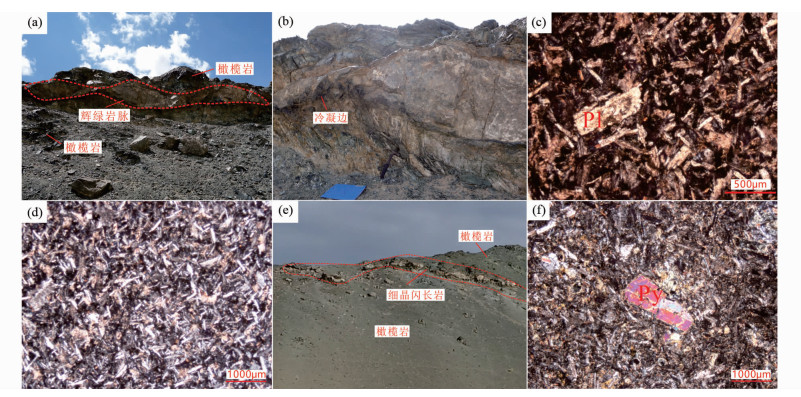
|
图 2 狮泉河辉绿岩及闪长岩野外露头照片及镜下照片 (a)侵位于橄榄岩中的透镜体化的辉绿岩;(b)辉绿岩脉与橄榄岩接触界面的冷凝边;(c)辉绿岩中的斜长石(Pl)斑晶;(d)辉绿岩中的辉绿结构;(e)侵位于橄榄岩中的闪长岩脉;(f)闪长岩中的辉石(Py)斑晶 Fig. 2 Shiquanhe diabase and diorite outcrop and microscopic photos (a) lenticular diabase dike in the peridotite; (b)chilled margin between the diabase and the peridotite; (c)plagioclase (Pl) phenocryst in the diabase; (d)diabaseic texture in the diabase; (e)diorite dike in the peridotite; (f)pyroxene (Py) phenocrysts in the diorite |
本次研究从狮泉河北部蛇绿岩内采集了约20kg辉绿岩样品用于进行了锆石U-Pb定年。为保证样品的可靠性,所采集的样品均去除表面杂质和次生风化薄壳以避免外部不相关锆石的混入。U-Pb锆石年代学研究样品首先采用重液分选和磁选将粉碎过后的样品进行初步分离的预处理。然后在双目显微镜下手工挑选出15颗锆石颗粒,所选锆石颗粒为自形到半自形,晶体长度为50~100μm,长宽比为2:1到3:1。挑选出的锆石颗粒被粘贴制成环氧树脂锆石靶并打磨抛光使其露出中心部位。最后,结合反射光、透射光和阴极发光图像观察锆石的内部结构并选择合适的U-Pb定年分析点,所选分析点(除3颗继承锆石)在透射光下无包裹体和裂隙,反射光下边缘无溶蚀,阴极发光图像下显示出明显的锆石震荡环带。锆石的分选、制靶和阴极发光采集均在北京锆年领航科技服务公司进行;锆石U-Pb同位素定年在中国科学院贵阳地球化学研究所利用Agilent 7500a LA-ICP-MS质谱仪分析完成,激光剥蚀束斑大小为24μm,采用91500标样作为锆石定年标样,NIST SRM 610标样作为锆石微量元素矫正标样。单个锆石测试数据的误差和206Pb/238U年龄的加权平均值误差均为1σ,由于所测试样品年龄较年轻故采用206Pb/238U年龄作为使用年龄,分析结果见表 1。详细的仪器操作条件和数据处理方法参见Liu et al.(2008, 2010)。经过普通铅校正后的数据使用Isoplot3 (Ludwig, 2003;Andersen, 2002)进行年龄的拟合计算。
|
|
表 1 狮泉河地区OIB型辉绿岩锆石U-Th-Pb同位素测定结果 Table 1 U-Th-Pb isotopic composition of zircons from OIB-type diabase in Shiquanhe area |
此外,在辉绿岩脉的不同位置选取了5个样品,在细晶闪长岩脉中采集了2个样品以进行全岩地球化学分析。为保证测试分析数据的可靠性,所采样品均为无蚀变的新鲜样品,同时采样过程尽量避开了岩石内部的后期微小细脉。样品的全岩地球化学分析在西南冶金地质测试中心完成。样品粉碎前先用无水乙醇清洁其表面,然后将样品粉碎成200目粉末并加热至920℃持续2h来计算灼烧量(LOI)。主量元素用Rigaku RIX2100型X荧光光谱仪分析完成,分析精度优于1%;微量元素通过ICP-MS测定,仪器型号为Agilent 7500a质谱仪,详细的样品消解处理过程、分析精密度和准确度同Liu et al. (2008),分析结果见表 2。
|
|
表 2 狮泉河辉绿岩和闪长岩主量元素(wt%)和微量元素(×10-6)数据 Table 2 Whole-rock major (wt%) and trace (×10-6) element data of the diabase and diorite samples in Shiquanhe |
通常较高的Th/U比值(>0.4)和震荡环带被认为是岩浆成因锆石的特征,而无环带或弱环带和低的Th/U比值(< 0.1)被认为是变质成因的锆石特征(Hoskin and Ireland, 2000; Wang et al., 2016)。本次所分析的锆石样品具有较高的Th/U比值(0.48~0.71)(表 1),以及部分明显的震荡环带(图 3a)。在锆石的球粒陨石标准化稀土元素配分模式图上(图 3b),锆石的轻稀土元素(LREE)亏损,重稀土元素(HREE)富集,并具有明显的Ce正异常(Ce/Ce*平均值=65.68)和Eu负异常(Eu/Eu*平均值=0.22),显示出岩浆锆石的成分特征(Hoskin and Schaltegger, 2003)。前人研究表明,岩浆锆石的微量元素含量从超基性岩,经过基性岩到中酸性岩石, 其含量总体上具有增长的趋势(∑REE=50×10-6~10000×10-6),其中基性岩中锆石REE总量约为2000×10-6(Hoskin, 2005; 赵志丹等,2018)。因此,狮泉河辉绿岩中的锆石极可能为基性岩浆成因的锆石(∑REE平均值=2327×10-6)。此外,对锆石部分微量元素及REE比值的判别((Sm/La)N=96~915;Ce/Ce*=12~215)也显示出了本次研究所涉及的锆石大部分为同岩浆期的岩浆锆石(Hoskin, 2005; 赵志丹等,2018)。
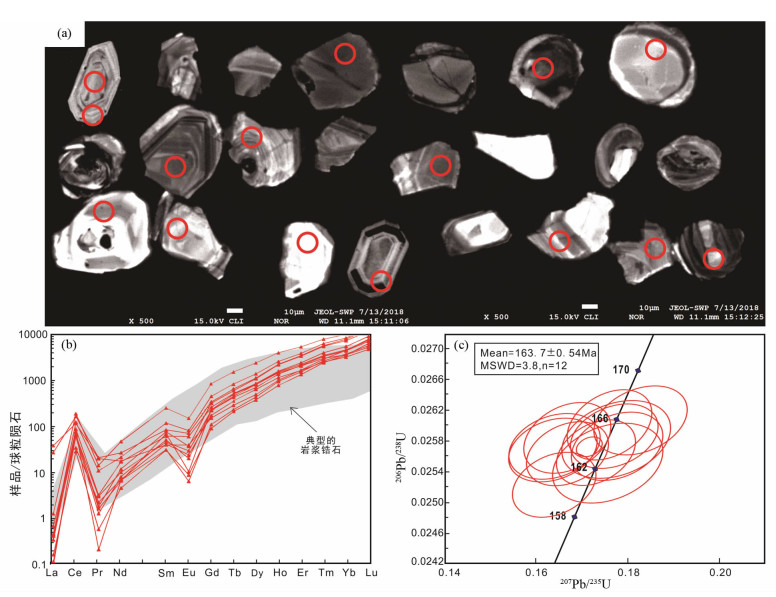
|
图 3 狮泉河OIB型辉绿岩锆石阴极发光及测试点位置图(a)、锆石的球粒陨石标准化REE模式图(b,标准化值据Sun and McDonough, 1989)及锆石U-Pb年龄协和图(c) Fig. 3 CL images of zircons from OIB-type diabases in Shiquanhe (a), chondrite-normalized REE patterns for dated zircons (b, normalization values after Sun and McDonough, 1989) and U-Pb zircon concordia diagram (c) |
本次研究所选取的15颗锆石中有3颗锆石有“核心-环带结构”(图 3a),并且在锆石核心部位分别产生了1249±12.3Ma(协和度=96%)、948±8.8Ma(协和度=98%)和796±8.8Ma(协和度=98%)的206Pb/238U年龄,推测为岩浆上涌过程中捕获锆石(Wang et al., 2016)。同时,12颗岩浆锆石测点均投影于谐和线上或谐和线附近(图 3c),计算出了163.7±0.54Ma(n=12,MSWD=3.8)的206Pb/238U年龄加权平均值,该年龄基本可以代表矿物结晶年龄,即辉绿岩脉的侵入年龄。
3.2 全岩地球化学本次分析的7件全岩地球化学样品的烧失量均小于1%,结合野外调查和镜下观察结果(图 2),认为所有样品仅发生了轻微程度的蚀变。因此,对于所有样品,主微量元素均重新归一化为无水的质量百分比,并且仅使用不易迁移的微量元素(如,高场强元素(HFSE)和稀土元素(REE))讨论上述样品的岩石学成因和演化过程(Wang et al., 2016)。由于岩浆来源相同的次火山岩和火山岩有相似的地球化学组成和性质(Dai et al., 2012),同时前人已有大量研究表明全岩地球化学性质相同的高镁安山岩与高镁闪长岩以及OIB型玄武岩和有着OIB化学性质的辉绿岩拥有相同的岩浆起源(Kamei et al., 2004; Zhou et al., 2009; 邓晋福等, 2010; Li et al., 2016)。此外,这些化学性质相同的次火山岩和火山岩常同时用于讨论岩石成因和构造背景(Kamei et al., 2004; Li et al., 2016)。因此,本次研究选用了一些火山岩的地球化学图解用于讨论上述次火山岩性质的细晶闪长岩和辉绿岩样品。
3.2.1 闪长岩本次所采集的细晶闪长岩样品的SiO2含量为55%~57%,K2O含量为1.9%~2.2%,Al2O3含量为15.7%~16.1%,MgO含量为7.1%~8.8%,FeOT(=FeO+ 0.9×Fe2O3)含量为5.86%~6.11%,Mg#为68.5~72.2,TiO2变化于0.94%~1.0%。在SiO2-Zr/TiO2图解中(图 4a),上述样品被分类为安山岩/闪长岩; 在FeOT/MgO-SiO2图解中显示为钙碱性的特征(图 4b); 在K2O-SiO2图解中所有样品均显示出了高K的特征,显示为高钾钙碱性系列(图 4c); 在SiO2-Mg#图解上(图 4d),所有闪长岩样品均投点到高镁安山岩/闪长岩(HMA)区域。
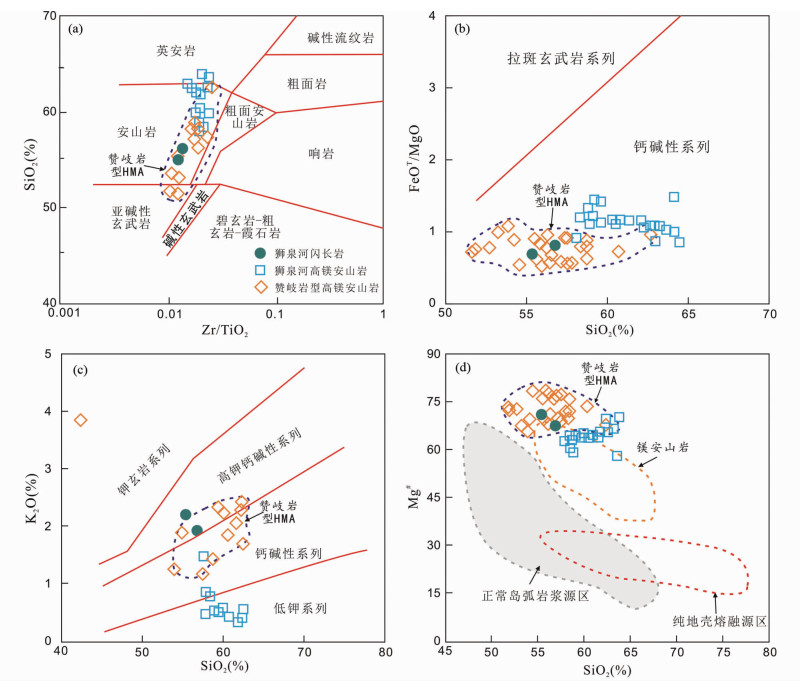
|
图 4 狮泉河闪长岩SiO2-Zr/TiO2图(a, 据Winchester and Floyd, 1977)、FeOT/MgO-SiO2图(b, 据Miyashiro, 1974)、K2O-SiO2图(c, 底图据Liu et al., 2018)和Mg#-SiO2图(d, 底图据Liu et al., 2018) 蓝色圆形为本次狮泉河闪长岩样品; 橙色菱形为赞岐岩型高镁安山岩样品(数据据Tatsumi, 2006),蓝色方形为Liu et al. (2018)所报道的狮泉河高镁安山岩样品 Fig. 4 Diagrams of SiO2 vs. Zr/TiO2(a, after Winchester and Floyd, 1977), FeOT/MgO vs. SiO2(b, after Miyashiro, 1974), K2O vs. SiO2(c, after Liu et al., 2018) and Mg# vs. SiO2(d, 据Liu et al., 2018) for diorite in the Shiquanhe area The blue circle is the diorite sample in the Shiquanhe area in this study; the orange diamond is the sample of the sanukite-type high-magnesium andesite (data from Tatsumi, 2006); the blue diamond is the lion spring high magnesium reported by Liu et al. (2018) |
此外,它们的稀土元素分配曲线为轻稀土富集型((La/Yb)N=8.9~10.1),基本无铕异常(Eu*=0.92~0.93)(图 5a)。在微量元素蛛网图上(图 5b),岩石富集Rb、Ba、Th等大离子亲石元素(LILE),并显示出Nb负异常的典型大陆地壳微量元素配分模式。同时,岩石具有有较高的Cr含量(153×10-6~163×10-6)和Ni含量(90.5×10-6~145×10-6)。
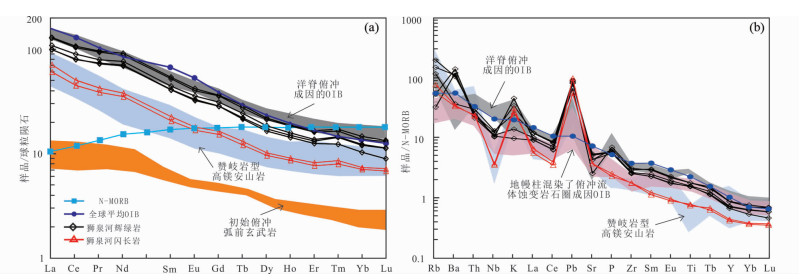
|
图 5 狮泉河样品的球粒陨石标准化稀土元素配分模式图(a)和N-MORB标准化微量元素蛛网图(b) 数据来源:球粒陨石、N-MORB、全球平均OIB(Sun and McDonough, 1989); 洋脊俯冲成因的玄武岩(Li et al., 2016); 赞岐岩型高镁安山岩(Liu et al., 2018; Tatsumi, 2006); 初始俯冲弧前玄武岩(Stern and Gerya, 2018) Fig. 5 Chondrite-normalized REE pattern (a) and primitive mantle-normalized trace-element spidergram (b) for the samples in the Shiquanhe area Data source: chondrite, N-MORB, global average OIB (Sun and McDonough, 1989); basalts formed by oceanic ridge subduction (Li et al., 2016); high-magnesia andesite associated with the sanukite rock (Liu et al., 2018; Tatsumi, 2006); fore-arc basalts associated with subduction initiation (Stern and Gerya, 2018) |
上述这些地球化学特征与日本西南部Setouchi火山带中的新生代高镁安山岩(Miyashiro, 1974; Shimoda et al., 1998; Tatsumi and Hanyu, 2003),青藏高原北部的晚三叠世Hohxil高镁安山岩(Wang et al., 2011),青藏高原BNSZ中段的中侏罗世Darutso高镁安山岩(Zeng et al., 2016b)以及西藏狮泉河北部的高镁安山岩(Liu et al., 2018)类似,符合高镁安山岩/闪长岩(HMA)的性质。
3.2.2 辉绿岩本次选取的辉绿岩样品的SiO2含量较低且变化较大(40.93%~49.88%),并伴随有较高含量的MgO(4.75%~8.19%)和Mg# (=Mg/(Mg+Fe)×100;46.32~60.42),TiO2含量变化于1.96%~2.27%,P2O5含量变化于0.51%~0.63%,FeOT含量变化于9.66%~11.58%,Al2O3含量变化于16.65%~20.35%,Na2O含量变化于4.41%~6.87%,K2O含量变化于0.70%~3.29%。同时,所测样品含有较高含量的Cr(25×10-6~133×10-6)和Ni(8.1×10-6~81.7×10-6)。在Zr/TiO2-Nb/Y图解中(图 6),所有样品均投点到碱性玄武岩中。
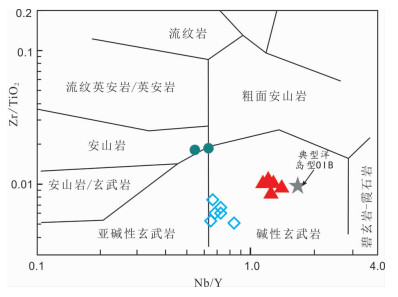
|
图 6 狮泉河辉绿岩Nb/Y-Zr/TiO2图解(据Winchester and Floyd, 1977) 红色三角型为本次辉绿岩样品;绿色圆形为本次闪长岩样品;蓝色菱形为夏威夷玄武岩样品 Fig. 6 Nb /Y-Zr / TiO2 diagram of the diabase dike in Shiquanhe area (after Winchester and Floyd, 1977) The red triangle is the diabase sample; the green circle is the diorite sample; the blue diamond is the Hawaiian basalt sample |
在球粒陨石标准化的稀土元素配分模式图(图 5a)和N-MORB标准化的微量元素蛛网图(图 5b)中,所有样品均富集轻稀土元素((La/Yb)N=8.67~10.1)和高场强元素(HFSEs),同时伴随有轻微的Nb负异常和强烈的Pb正异常,无明显Eu异常(Eu/Eu*=0.91~0.95)。上述特征与已证实为洋脊俯冲成因的的班公湖怒江缝合带中段的OIB型基性岩相似(Li et al., 2016)。
4 讨论 4.1 形成时代及其地质意义从狮泉河北部辉绿岩脉中挑出的12颗岩浆锆石的加权平均年龄为163.7±0.54Ma(n=12,MSWD=3.8)。指示了该辉绿岩在俯冲带增生楔中的就位时间。该年龄与近年来狮泉河-纳木错蛇绿岩带附近报道的俯冲带相关的中-晚侏罗世的各类岩浆岩年龄较为接近(图 1),如:165.8±1.7Ma(闪长岩;郑有业等, 2006)、163.35±0.75Ma(辉长岩-闪长岩;郑有业等, 2006)、160.8±2.3Ma(高镁安山岩;Liu et al., 2018)。上述时代接近的不同岩浆岩被解释为不同的成因类型,其中Liu et al. (2018)所报道的160.8±2.3Ma的高镁安山岩被解释为俯冲沉积物的部分熔融和年轻洋壳的部分熔融作为物源的赞岐岩型高镁安山岩。
4.2 岩石形成的P-T条件 4.2.1 闪长岩在岩浆岩源区结晶分异的过程中,许多微量元素的浓度和比值取决于残余矿物相的性质(Johnson and Plank, 2000; Spandler et al., 2008; Hermann and Rubatto, 2009; Skora and Blundy, 2010; Liu et al., 2018)。例如,在锆石中由于Zr元素的分配系数高于Hf元素(Blundy and Wood, 2003),所以,球粒陨石标准化后Zr/Hf比值则能指示了部分熔融后岩浆岩中锆石的相对含量(Blundy and Wood, 2003; Nebel et al., 2011)。锆石由于存在较高的饱和结晶温度(731~846℃; Watson and Harrison, 1983),所以本次研究的闪长岩中较高(Zr/Hf)N(0.97~0.99;球粒陨石标准化值,Sun and McDonough, 1989 )反映了闪长岩形成于较高温的环境下。
稀土元素在角闪石中具有高度的相容性,有着角闪石残余相的部分熔融的俯冲洋壳可以产生较高的Zr/Sm比值和较低的Sm/Hf比值(Green, 1994; Sisson, 1994)。本次研究的闪长岩与全球平均OIB相比(Sm/Hf =1.42,Zr/Sm=22.49;Plank and Langmuir, 1998 )具有的较低的Nb/Ta比值(12.8~13.0),Hf/Sm比值(1.13~1.25)和较高的Zr/Sm比值(40.6~44.0),指示了岩浆形成于有残余角闪石相的低压条件下(Hanyu et al., 2006)。因此,本文认为本次研究的闪长岩形成于高温-低压环境。
4.2.2 辉绿岩通常,地幔衍生的初级熔体具有较高的Ni含量(>400×10-6)、Cr含量(>1000×10-6)和Mg#(73~81)(Wilson, 2007),而本次研究的OIB型辉绿岩显示出了变化较大的Mg#值(46.3~60.4),并伴随有变化较大的相容元素含量:Cr=25×10-6~133×10-6),Ni=8.1×10-6~81.7×10-6),表明橄榄石已经发生了显着的分馏。同时,在辉绿岩中观察到的主要斑晶是斜长石斑晶(图 2c),指示了低压分馏阶段(Tang et al., 2012)。
4.3 岩石成因 4.3.1 HMA型闪长岩通过全岩地球化学分析结果认为本次发现的侵位于超基性岩内的闪长岩脉为高镁安山岩/闪长岩(HMA)性质,且与最近前人所报道的狮泉河北部高镁安山岩(Liu et al., 2018)性质较为接近。高镁安山岩的岩石成因目前有几种模型:1)俯冲板部分熔融后与上覆增生楔的相互作用(Hanyu et al., 2003, 2006; Wang et al., 2011, Zeng et al., 2016b);2)拆沉后的下地壳在软流圈中熔融形成的熔体在上升过程中与地幔橄榄岩的相互作用(Xu et al., 2002; Gao et al., 2004);3)含水地幔橄榄岩的部分熔融(Wood and Turner, 2009; Straub et al., 2011);4)不同性质的岩浆的混合作用(Qian and Hermann, 2010);5)部分熔融的俯冲海沟沉积物与地幔橄榄岩之间相互作用(Zeng et al., 2016b; Liu et al., 2018);6)较为年轻的热的洋壳的部分熔融(Yogodzinski et al., 1995; Furukawa and Tatsumi, 1999; Kamei et al., 2004)。这几种成因模式主要产生了4种高镁安山岩的岩石类型:赞岐岩型、埃达克型、巴哈岩型和玻安岩型(Kay, 1978; Rogers et al., 1985; Bloomer and Hawkins, 1987; Tatsumi, 2006; 唐功建和王强, 2010)。与赞岐岩型相比:埃达克型和巴哈岩型具有较高的Sr、Sr/Y和(La/Yb)N值(Rogers et al., 1985; Martin, 1999),玻安岩型具有较低的TiO2、HFSE、REE和大离子亲石元素(LILE)(Bloomer and Hawkins, 1987),通过对上述不同地球化学特征的对比(图 7),本次研究的狮泉河北部的高镁HMA具有较高的TiO2含量,Y含量和Yb含量以及较低的Sr/Y比值和La/Yb比值(图 7),结合微量元素蛛网图的对比(图 5),本文认为狮泉河高镁安山岩的特征与出露于日本中新世Setouchi火山岩带的赞岐岩极为相似。
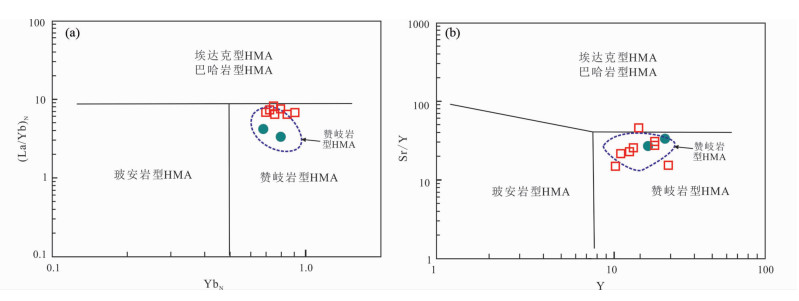
|
图 7 赞岐岩与埃达克岩、玻安岩和bajaite的对比(据Kamei et al., 2004) Fig. 7 Comparison of sanukitic HMA to adakitic HMA, boninitic HMA and bajaitic HMA(after Kamei et al., 2004) |
赞岐岩已被公认为是熔融俯冲板片沉积物熔体与上覆地幔楔相互作用的产物(Shimoda et al., 1998; Wang et al., 2011)。本文认为狮泉河赞岐岩型闪长岩也是这种教科书模式的成因,该推断同时基于以下证据:1)Th元素和Ta元素大量富集于海相沉积物中,同时U元素和Nb元素也与海相沉积物密切相关(Plank and Langmuir, 1998)。因此,本次研究的HMA中较低的U/Th(0.24~0.25)和Nb/Ta(12.7~13.0)具有极其类似于全球俯冲沉积物(GLOSS)的特点(GLOSS:U/Th=0.24,Nb/Ta=14.19;Plank and Langmuir, 1998 );2)根据Labanieh et al. (2018)对小安地列斯群岛Martinique岛弧的研究结果,La/Sm比值可以指示混入到地幔楔中熔融的海沟沉积物的相对含量。因此,本次研究较高的La/Sm比值指示了海沟沉积物部分熔融为HMA提供了部分物源;3)本次研究的HMA的MgO、Cr和Ni的含量均较高,表明其源区有地幔的部分熔融(Stern and Hanson, 1991; Smithies and Champion, 2000),而不可能为单一的洋壳沉积物熔融体。
通过上述分析,笔者认为狮泉河赞岐岩型的闪长岩为俯冲沉积物与地幔熔体相互作用的结果。俯冲带正常的地热梯度通常只会在俯冲板块(包括沉积物)开始融化之前使洋壳脱水(Tatsumi, 2006)。因此,通过沉积物衍生的熔体与年轻上覆地幔楔的相互作用形成的高镁安山岩(赞岐岩)只能存在于异常的地热梯度区域,如洋脊俯冲的板片窗环境(Wang et al., 2011)和俯冲早期阶段的弧前热异常环境(Tatsumi, 2006;Zeng et al., 2016b)。但洋脊俯冲模式下的高镁安山岩会有埃达克岩的地球化学性质(Tang et al., 2010),该特征与本次研究的闪长岩不符。因此我们在此提出,狮泉河赞岐岩型闪长岩形成于俯冲早期阶段的弧前热异常环境,并且很可能是狮泉河蛇绿岩带的初始俯冲阶段。在较高的地热梯度下,板片的熔融将会发生在俯冲的较浅部地区,并伴随含白云母矿物的熔融产生贫Sr的安山质岩浆( Weinberg and Hasalová, 2015 ),该特征符合本次研究的闪长岩的特征(图 5)。此外,狮泉河闪长岩较高的(Zr/Hf)N(0.97~0.99)、Zr/Sm比值(40.6~44.0)和较低的Hf/Sm比值推测出的高温-低压成岩环境也与初始俯冲模型中的温压条件相符合。
4.3.2 OIB型辉绿岩OIB型玄武岩浆的形成和演化,涉及到来自地幔柱、软流圈、岩石圈地幔和地壳等不同端元组分的贡献(徐义刚, 2002)。因此,要分析其地幔源区的性质,首先要考察地壳物质对岩浆源区的影响(朱弟成等, 2006)。在N-MORB标准化的微量元素蛛网图上可以很明显的看出,本次OIB型的玄武岩与全球平均的OIB型的玄武岩相比有明显的Nb负异常、轻微的Ti负异常、强烈Pb正异常以及变化的Sr含量与Sr负异常(图 5b)。该特征反映了岩浆作用过程中的地壳混染以及岩石圈拉张过程中的岩石圈富集组分部分熔融(Huang et al., 2013; 杨帆等, 2018)。
某些特定元素和特定指数之间的相关性可以指示了辉绿岩的结晶分异过程(Dai et al., 2012)。在以Mg#为横轴,Cr和Ni分别为纵轴的二元图解上,Cr和Ni均表现出和Mg#较强的相关性(图 8a, b),指示了样品经历了镁铁质矿物(如橄榄石、尖晶石和辉石)的分离结晶作用。在以Mg#为横轴,Al2O3和Sr分别为纵轴的二元图解上,Al2O3和Sr与Mg#的负相关性指示了斜长石没有发生明显的分异过程(图 8c, d),这与REE配分图中缺失Eu负异常的特征所反映出的结论一致(图 5a)。
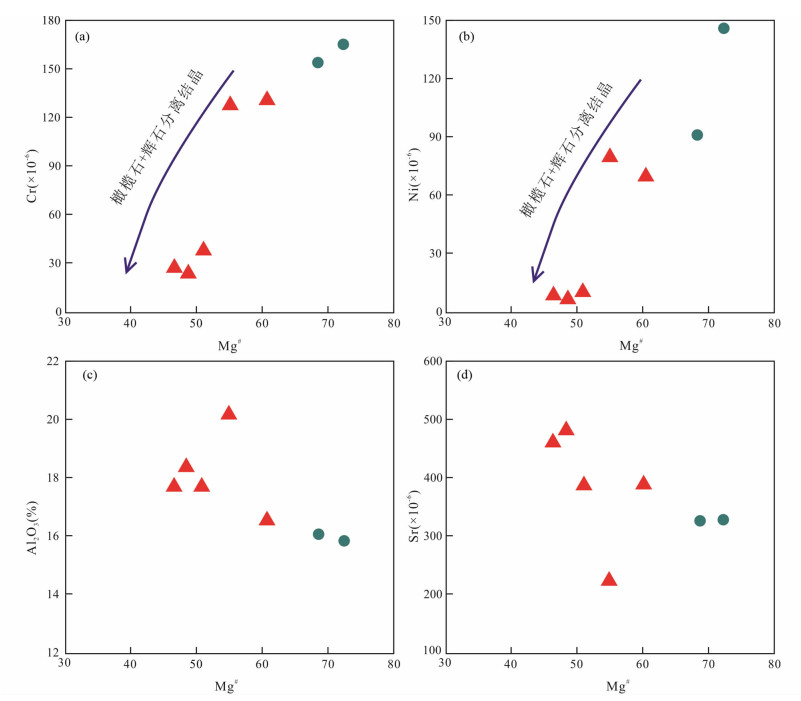
|
图 8 狮泉河辉绿岩和闪长岩的Harker图解 红色三角形为本次研究的辉绿岩,蓝色圆形为闪长岩 Fig. 8 Harker diagrams of the diabase and the diorite in shiquanhe The red triangle is the diabase of this study, and the blue circle is diorite |
狮泉河辉绿岩具有明显的富集不相容元素和REE(图 5a, b),同时其球粒陨石标准化之后的REE配分图和N-MORB标准化之后的微量元素蛛网图显示出和全球平均洋岛玄武岩(OIB)较强的相似性(Fig. 5a, b,Sun and McDonough, 1989)。上述特征均指示了该辉绿岩和典型的洋岛玄武岩(OIB)有相同的物质组成(OIB; Hofmann, 1997)。此外,所研究的样品在Zr/Y-Zr图解上显示出较高的Zr/Y比值(图 9a),在TiO2/Yb-Nb/Yb图解上显示出较高的TiO2/Yb比值和Nb/Yb比值(图 9b),结合在2×Nb-Zr/4-Y三元图解和Ti/100-Zr-Y×3三元图解中的投点结果(图 9c, d),本文认为该基性岩具有OIB地球化学特征,即其来源于富集的地幔软流圈(朱弟成等, 2006; Dai et al., 2012)。
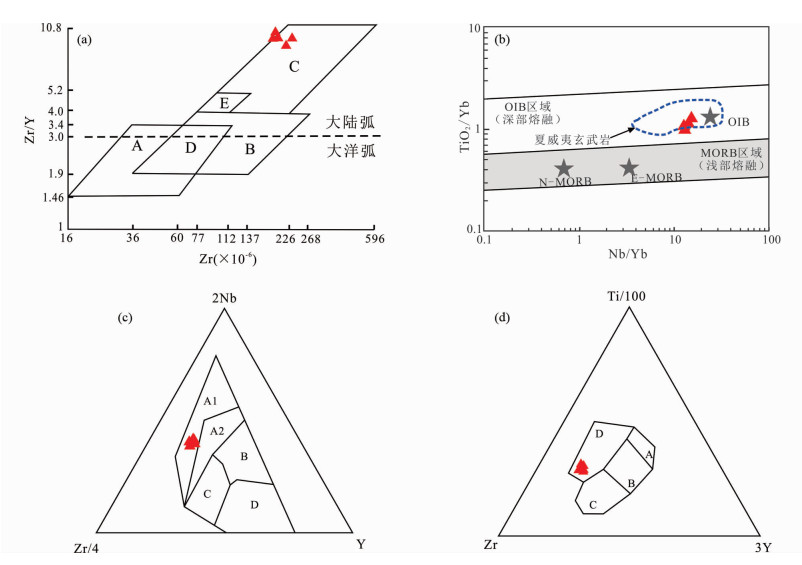
|
图 9 狮泉河辉绿岩不活动微量元素构造环境判别图解 Fig. 9 Tectonic discrimination diagrams based on immobile trace elements for the diabase in the Shiquanhe area (a) Zr/Y vs. Zr diagram (Pearce and Norry, 1979), A=volcanic arc basalt; B=mid-ocean ridge basalt; C=within-plate basalt; D=mid-ocean ridge basalt and volcanic arc basalt; E=mid-ocean ridge basalt and within-plate basalt. (b) TiO2/Yb vs. Nb/Yb diagram (Pearce et al., 1992). (c) 2×Nb-Zr/4-Y diagram (Meschede, 1986), A1=within-plate alkaline basalt; A2=within-plate alkaline basalt and intraplate tholeiite; B=enriched mid-ocean ridge basalt; C=intraplate tholeiite and volcanic arc basalt; D=volcanic arc basalt and normal-mid-ocean ridge basalt. (d) Ti/100-Zr-Y×3 diagram (Pearce and Cann, 1973), A=island arc tholeiite; B=mid-ocean ridge basalt; C=calc-alkaline basalt; D=within-plate basalt |
板内洋岛玄武岩(OIB)通常被认为与“热点”或“地幔柱”有关(牛耀龄, 2010),其典型的类型有夏威夷洋岛碱性玄武岩和峨眉山高Ti型陆内玄武岩(徐义刚,2002)。此外,在现代俯冲带中也大量发现了具有OIB型地球化学特征的碱性基性岩(Rogers et al., 1985; Reagan and Gill, 1989; Gorring and Kay, 2001)。这些基性岩指示了一些特定的俯冲过程,如:洋中脊俯冲(Abratis and Wörner, 2001),俯冲终止导致的板片断离(蓝江波等, 2007;Li et al., 2014b, Liu et al., 2014, Zhu et al., 2016),俯初始俯冲之后弧后拉张成因(Faccenna et al., 2010)。在上述类型中,夏威夷玄武岩由于没有陆壳岩石圈,故其成因上上没有任何岩石圈混染(朱弟成,2006),峨眉山大火成岩省玄武岩由于存在特殊的地幔柱-岩石圈的相互作用而显示出了高Ti(TiO2=4.25%~4.63%)的地球化学特征(图 10,Xu et al., 2001)。上述特征不符合狮泉河OIB型辉绿岩存在地壳混染(Nb负异常、轻微的Ti负异常、强烈Pb正异常)和低含量的Ti含量(TiO2=1.96%~2.27%)的特征。而就位于俯冲带上的基性岩通常与板片流体和板片熔融体交代过的地幔楔中的橄榄岩的部分熔融有关(Wilson, 1989)。这些基性岩以钙碱性系列(成熟的岛弧和陆缘弧)为主,并伴随少量的拉斑玄武岩系列(原始岛弧)(Stern, 2002),通常显示出HFSE(如Nb和Ta)的亏损和LILE的富集(Wilson, 1989; Stern, 2002),该特征与本次研究的辉绿岩一致,此外,通过岩浆锆石反映出的岩石结晶的大致温度与俯冲带成因的铁镁质岩的结晶温度区间相似(图 11),故本次研究的辉绿岩的成因应该与俯冲作用密切相关。

|
图 10 狮泉河辉绿岩Nb/Th-Ti/Yb图解 数据来源:N-MORB, E-MORB(Sun and McDonough, 1989);上地壳和下地壳(Rudnick and Fountain, 1995);峨眉山高Ti玄武岩(Xu et al., 2001) Fig. 10 Nb/Th vs. Ti/Yb diagram of the Shiquanhe diabase Data sources: N-MORB, E-MORB(Sun and McDonough, 1989); upper crust and lower crust (Rudnick and Fountain, 1995); Emei high-Ti basalt(Xu et al., 2001) |
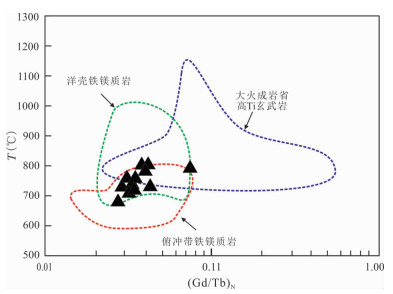
|
图 11 狮泉河OIB-型镁铁质岩的锆石Ti温度-(Gd/Yb)N散点图据(夏瑛等, 2012; 高晓英和郑永飞, 2011) Fig. 11 Scatter plot of Ti-in-zircon temperature vs. (Gd/Yb)N of the OIB-type mafic rocks in the Shiquanhe area(after Xia et al., 2012; Gao and Zheng, 2011) |
俯冲带中就位的OIB型岩浆的起源目前有两种公认的成岩模式:1)被俯冲板片的部分熔融物(埃达克质熔体)交代过的地幔楔源的部分熔融(Defant et al., 1992, Sajona et al., 1996);2)洋脊俯冲成因的OIB(Reagan and Gill, 1989; Thorkelson et al., 2011)。由于俯冲板片熔融物在交代地幔橄榄岩时,会形成富集HFSF的矿物相(Kepezhinskas et al., 1996),因此,板片熔体交代过的地幔源区派生的玄武岩具有富Nb的特点(Sajona et al., 1996; Wang et al., 2008),而本次研究的OIB型基性岩不具有富Nb的特征。所以,俯冲板片对地幔的交代产生OIB的成因不符合本次研究的辉绿岩的特征。此外,由于HREE在石榴子石中具有较强的相容性,所以Sm/Yb比值可以反映地幔橄榄岩源区中石榴子石和尖晶石含量(Rollinson,1993),同时实验表明La/Yb比值随着部分熔化程度的增加而降低(Aldanmaz et al., 2000; Zhu et al., 2008)。从含尖晶石的地幔中分异出的基性岩浆比含石榴子石的地幔中分异出的岩浆有更低的Sm/Yb比值和La/Yb比值,所以这两个比值可以用于判断基性岩源区性质以及地幔部分熔融的深度(Aldanmaz et al., 2000)。在Sm/Yb-La/Yb图中(图 12),狮泉河OIB型辉绿岩与洋脊俯冲成因的OIB相比,有更深的源区熔融深度并且显示出了更接近含石榴子石橄榄岩的源区性质(图 12)。综上所述,现有的俯冲带相关的OIB成因理论并不能很好的解释狮泉河OIB型辉绿岩的就位机制。
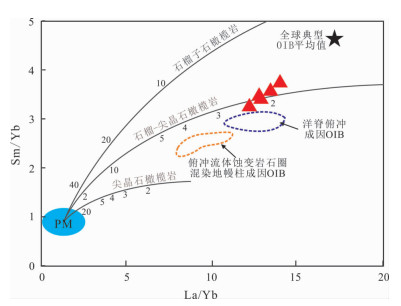
|
图 12 狮泉河镁铁质岩石的Sm/Yb-La/Yb图(据Zhao and Zhou, 2009) Fig. 12 Sm/Yb vs. La/Yb diagrams for the Shiquanhe mafic rocks (melting curves is after Zhao and Zhou, 2009) |
狮泉河辉绿岩与上述证明为初始俯冲成因的赞岐岩均侵入于狮泉河蛇绿岩带上的橄榄岩内(图 2),这种就位产状与最近Liu et al. (2018)报道的狮泉河北东侧的160.8±2.3Ma的洋内初始俯冲成因的高镁安山岩的就位产状一致。鉴于两处高镁安山岩处于同一大地构造背景,在野外的分布距离较近并且有着相似的成因机制,推测两者的侵位时间应该均为中侏罗世晚期。因此,同样为中侏罗世晚期侵位的狮泉河OIB型辉绿岩应该与狮泉河高镁安山岩有着相似的初始俯冲成因机制。然而,即使在研究程度较高Izu-Bonin-Mariana (IBM)的初始俯冲相关的弧前序列中也没有相关的OIB型玄武岩(Stern, 2002; Reagan et al., 2013)。但是,同时也注意到在初始俯冲之后的一段时间内在俯冲带的弧后区域可以形成地幔柱相关的OIB(Reagan et al., 2013; Liu et al., 2016)。在这种特殊的OIB成因模式中,俯冲作用与地幔柱相互之间的诱发机制尚未研究清楚。但是Faccenna et al.(2010)通过模拟实验尝试提出了一种解释:俯冲过程开始之后不久由于“回返作用(rollback)”,会在弧后区域形成一个拉张环境(Faccenna et al., 2005)。同时,下行的俯冲板片边缘显示出有活跃的上升物质,这种机制增强了深源地幔和上部物质之间的混合,产生与之相关的碱性OIB型岩浆。这种有着典型地幔亲缘性的OIB岩浆在弧后张性环境中伴随有上部地壳的混染特征而上涌,产生了与俯冲成因的岛弧不同的“异常”岩浆作用(OIB型基性岩)。这种模式的提出解释了现代很多俯冲带附近的与经典岛弧岩浆岩地球化学性质完全不同的OIB型岩浆岩,如地中海直布罗陀俯冲带中的碱性OIB型玄武岩(Duggen et al., 2003; Faccenna et al., 2004)。笔者认为狮泉河OIB型辉绿岩可能为这种成因机制下的产物,理由如下:1)典型的OIB地球化学性质(极度富集的LREE模式以及较高的Zr/Y比值、TiO2/Yb比值和Nb/Yb比值)指示了地幔来源;2)Nb、Ti的负异常和强烈Pb正异表现出了岩浆作用过程中岩石圈的地壳混染;3)狮泉河OIB型辉绿岩的物源形成于中高温-低压环境,与地幔柱(高温)成因以及初始俯冲拉张(低压)的环境一致。因此,上述OIB型辉绿岩可能指示了狮泉河蛇绿岩带在洋内初始俯冲之后一段时间内存在俯冲相关的地幔柱。
4.4 岩石形成的演化过程本次在狮泉河北约10km发现了具有OIB型的辉绿岩以及高镁安山岩型的闪长岩。闪长岩具有与典型的赞岐岩相似的较高的TiO2含量,Y含量和Yb含量以及较低的Sr/Y比值和La/Yb比值。其U/Th、Nb/Ta和La/Sm指示了源区有俯冲沉积物的贡献,较高的MgO、Cr和Ni含量指示了有地幔物质的参与。其成因需要较高的地温梯度,同时排除洋脊俯冲的成因可能。因此,认为狮泉河高镁安山岩型闪长岩为俯冲早期阶段的弧前热异常环境下熔融的俯冲板片沉积物与上覆地幔楔相互作用的产物。OIB型的辉绿岩的REE配分图和微量元素蛛网图显示出和全球平均洋岛玄武岩(OIB)较强的相似性。Nb负异常、Pb正异常、以及变化的Sr异常指示了岩浆作用过程中的地壳混染以及富集组分部分熔融。Zr/TiO2比值、Nb/Y比值、MgO/SiO2比值、Nb/Zr比值、Nb/Th比值、Ti/Yb比值、La/Sm比值和Sm/Yb比值指示了与现有的俯冲带相关的OIB成因理论不一致的一个俯冲相关的地幔柱成因。结合OIB型辉绿岩中获得的协和度较高的163.7±0.54Ma的岩浆年龄,我们提出了一个中侏罗世晚期班-怒洋在狮泉河地区的早期俯冲模式(图 13):中侏罗世晚期(163.7±0.54Ma)班-怒洋在狮泉河蛇绿岩带的北向初始俯冲过程开始之后不久,俯冲沉积物在浅部发生部分熔融,熔体与上覆地幔楔反应,在弧前区域产生了和日本中新世Setouchi火山岩带的赞岐岩较为相似的高镁安山质岩浆。随后在增生楔下由于弧后拉张作用(或其他机制)产生了与俯冲相关的地幔柱成因的OIB型岩浆。

|
图 13 狮泉河俯冲带早期洋壳俯冲演化的地球动力学模型 Fig. 13 Geodynamic model for the evolution of the northward subduction of oceanic crust along the Shiquanhe suture at the early stage |
(1) 侵位于狮泉河北部的蛇绿岩中的辉绿岩和闪长岩分别表现出了典型的OIB型基性岩的特征和赞岐岩型的高镁闪长岩特征。
(2) OIB型辉绿岩的锆石U-Pb定年产生了163.7±0.54Ma(n=12,MSWD=3.8)的206Pb/238U加权平均年龄,以及1251Ma、800Ma和948Ma的继承锆石年龄。
(3) OIB型辉绿岩和HMA型闪长岩的地球化学特征和年代学特征指示了一个中晚侏罗世晚期班-怒洋在狮泉河地区的早期俯冲模式。
Abratis M and Wörner G. 2001. Ridge collision, slab-window formation, and the flux of Pacific asthenosphere into the Caribbean realm. Geology, 29(2): 127-130. DOI:10.1130/0091-7613(2001)029<0127:RCSWFA>2.0.CO;2 |
Aldanmaz E, Pearce JA, Thirlwall MF and Mitchell JG. 2000. Petrogenetic evolution of Late Cenozoic, post-collision volcanism in western Anatolia, Turkey. Journal of Volcanology and Geothermal Research, 102(1-2): 67-95. DOI:10.1016/S0377-0273(00)00182-7 |
Andersen T. 2002. Correction of common lead in U-Pb analyses that do not report 204Pb. Chemical Geology, 192(1-2): 59-79. DOI:10.1016/S0009-2541(02)00195-X |
Bloomer SH and Hawkins JW. 1987. Petrology and geochemistry of boninite series volcanic rocks from the Mariana trench. Contributions to Mineralogy and Petrology, 97(3): 361-377. DOI:10.1007/BF00371999 |
Blundy J and Wood B. 2003. Partitioning of trace elements between crystals and melts. Earth and Planetary Science Letters, 210(3-4): 383-397. DOI:10.1016/S0012-821X(03)00129-8 |
Dai JG, Wang CS and Li YL. 2012. Relicts of the Early Cretaceous seamounts in the central-western Yarlung Zangbo Suture Zone, southern Tibet. Journal of Asian Earth Sciences, 53: 25-37. DOI:10.1016/j.jseaes.2011.12.024 |
Defant MJ, Jackson TE, Drummond MS, de Boer JZ, Bellon H, Feigenson MD, Maury RC and Stewart RH. 1992. The geochemistry of young volcanism throughout western Panama and southeastern Costa Rica:An overview. Journal of the Geological Society, 149(4): 569-579. DOI:10.1144/gsjgs.149.4.0569 |
Deng JF, Liu C, Feng YF, Xiao QH, Su SG, Zhao GC, Kong WQ and Cao WY. 2010. High magnesian andesitic/dioritic rocks (HMA) and magnesian andesitic/dioritic rocks (MA):Two igneous rock types related to oceanic subduction. Geology in China, 37(4): 1112-1118. |
Duggen S, Hoernle K, Van den Bogaard P, Rüpke L and Morgan JP. 2003. Deep roots of the Messinian salinity crisis. Nature, 422(6932): 602-606. DOI:10.1038/nature01553 |
Faccenna C, Piromallo C, Crespo-Blanc A, Jolivet L and Rossetti F. 2004. Lateral slab deformation and the origin of the western Mediterranean arcs. Tectonics, 23(1): TC1012. |
Faccenna C, Civetta L, D'Antonio M, Funiciello F, Margheriti L and Piromallo C. 2005. Constraints on mantle circulation around the deforming Calabrian slab. Geophysical Research Letters, 32(6): L06311. |
Faccenna C, Becker TW, Lallemand S, Lagabrielle Y, Funiciello F and Piromallo C. 2010. Subduction-triggered magmatic pulses:A new class of plumes?. Earth and Planetary Science Letters, 299(1-2): 54-68. DOI:10.1016/j.epsl.2010.08.012 |
Furukawa Y and Tatsumi Y. 1999. Melting of a subducting slab and production of high-Mg andesite magmas:Unusual magmatism in SW Japan at 13~15Ma. Geophysical Research Letters, 26(15): 2271-2274. DOI:10.1029/1999GL900512 |
Girardeau J, Marcoux J, Fourcade E, Bassoullet JP and Youking T. 1985. Xainxa ultramafic rocks, central Tibet, China:Tectonic environment and geodynamic significance. Geology, 13(5): 330. DOI:10.1130/0091-7613(1985)13<330:XURCTC>2.0.CO;2 |
Gao S, Rudnick RL, Yuan HL, Liu XM, Liu YS, Xu WL, Ling WL, Ayers J, Wang XC and Wang QH. 2004. Recycling lower continental crust in the North China craton. Nature, 432(7019): 892-897. DOI:10.1038/nature03162 |
Gao XY and Zheng YF. 2011. On the Zr-in-rutile and Ti-in-zircon geothermometers. Acta Petrologica Sinica, 27(2): 417-432. |
Gehrels G, Kapp P, DeCelles P, Pullen A, Blakey R, Weislogel A, Ding L, Guynn J, Martin A, McQuarrie N and Yin A. 2011. Detrital zircon geochronology of pre-Tertiary strata in the Tibetan-Himalayan orogen. Tectonics, 30(5): TC5016. |
Gorring ML and Kay SM. 2001. Mantle processes and sources of Neogene slab window magmas from Southern Patagonia, Argentina. Journal of Petrology, 42(6): 1067-1094. DOI:10.1093/petrology/42.6.1067 |
Green TH. 1994. Experimental studies of trace-element partitioning applicable to igneous petrogenesis:Sedona 16 years later. Chemical Geology, 117(1-4): 1-36. DOI:10.1016/0009-2541(94)90119-8 |
Hanyu T, Tatsumi Y and Nakai S. 2003. Evidence of slab melting for the formation of high-Mg andesite: A Hafnium isotope study of Setouchi volcanics, Japan. In: Geophysical Research Abstracts, Vol. 5. Washington: EGS
|
Hanyu T, Tatsumi Y, Nakai S, Chang Q, Miyazaki T, Sato K, Tani K, Shibata T and Yoshida T. 2006. Contribution of slab melting and slab dehydration to magmatism in the Japanese arc. Geochimica et Cosmochimica Acta, 70(S18): A229. |
Hermann J and Rubatto D. 2009. Accessory phase control on the trace element signature of sediment melts in subduction zones. Chemical Geology, 265(3-4): 512-526. DOI:10.1016/j.chemgeo.2009.05.018 |
Hofmann AW. 1997. Mantle geochemistry:The message from oceanic volcanism. Nature, 385(6613): 219-229. DOI:10.1038/385219a0 |
Hoskin PWO and Ireland TR. 2000. Rare earth element chemistry of zircon and its use as a provenance indicator. Geology, 28(7): 627. DOI:10.1130/0091-7613(2000)28<627:REECOZ>2.0.CO;2 |
Hoskin PWO and Schaltegger U. 2003. The composition of zircon and igneous and metamorphic petrogenesis. Reviews in Mineralogy and Geochemistry, 53(1): 27-62. |
Hoskin PWO. 2005. Trace-element composition of hydrothermal zircon and the alteration of Hadean zircon from the Jack Hills, Australia. Geochimica et Cosmochimica Acta, 69(3): 637-648. DOI:10.1016/j.gca.2004.07.006 |
Hu J, Li Q, Fang NQ, Yang JY and Ge DS. 2015. Geochemistry characteristics of the Low Permian sedimentary rocks from central uplift zone, Qiangtang Basin, Tibet:Insights into source-area weathering, provenance, recycling, and tectonic setting. Arabian Journal of Geosciences, 8(8): 5373-5388. DOI:10.1007/s12517-014-1583-8 |
Huang TT, Xu JF, Chen JL, Wu JB and Zeng YC. 2017. Sedimentary record of Jurassic northward subduction of the Bangong-Nujiang Ocean:Insights from detrital zircons. International Geology Review, 59(2): 166-184. DOI:10.1080/00206814.2016.1218801 |
Huang XL, Niu YL, Xu YG, Ma JL, Qiu HN and Niu JW. 2013. Geochronology and geochemistry of Cenozoic basalts from eastern Guangdong, SE China:Constraints on the lithosphere evolution beneath the northern margin of the South China Sea. Contributions to Mineralogy and Petrology, 165(3): 437-455. DOI:10.1007/s00410-012-0816-7 |
Johnson MC and Plank T. 2000. Dehydration and melting experiments constrain the fate of subducted sediments. Geochemistry, Geophysics, Geosystems, 1(12): 1007. |
Kamei A, Owada M, Nagao T and Shiraki K. 2004. High-Mg diorites derived from sanukitic HMA magmas, Kyushu Island, Southwest Japan arc:Evidence from clinopyroxene and whole rock compositions. Lithos, 75(3-4): 359-371. DOI:10.1016/j.lithos.2004.03.006 |
Kapp P, Murphy MA, Yin A, Harrison TM, Ding L and Guo JH. 2003. Mesozoic and Cenozoic tectonic evolution of the Shiquanhe area of western Tibet. Tectonics, 22(4): 1029. |
Kapp P, Yin A, Harrison TM and Ding L. 2005. Cretaceous-Tertiary shortening, basin development, and volcanism in central Tibet. Geological Society of America Bulletin, 117(7-8): 865-878. |
Kapp P, Decelles PG, Gehrels GE, Heizler M and Ding L. 2007. Geological records of the Lhasa-Qiangtang and Indo-Asian collisions in the Nima area of central Tibet. Geological Society of America Bulletin, 119(7-8): 917-933. DOI:10.1130/B26033.1 |
Kay RW. 1978. Aleutian magnesian andesites:Melts from subducted Pacific Ocean crust. Journal of Volcanology and Geothermal Research, 4(1-2): 117-132. DOI:10.1016/0377-0273(78)90032-X |
Kepezhinskas P, Defant MJ and Drummond MS. 1996. Progressive enrichment of island arc mantle by melt-peridotite interaction inferred from Kamchatka xenoliths. Geochimica et Cosmochimica Acta, 60(7): 1217-1229. DOI:10.1016/0016-7037(96)00001-4 |
Labanieh S, Chauvel C, Germa A and Quidelleur X. 2018. Martinique:A clear case for sediment melting and slab dehydration as a function of distance to the trench. Journal of Petrology, 53(12): 2441-2464. |
Lan JB, Xu YG, Yang QJ and Huang XL. 2007. 2007.~40Ma OIB-type mafic magmatism in the Gaoligong belt:Results of break-off between subducting Tethyan slab and Indian Plate?. Acta Petrologica Sinica, 23(6): 1334-1346. |
Li JX, Qin KZ, Li GM, Richards JP, Zhao JX and Cao MJ. 2014a. Geochronology, geochemistry, and zircon Hf isotopic compositions of Mesozoic intermediate-felsic intrusions in central Tibet:Petrogenetic and tectonic implications. Lithos, 198-199: 77-91. DOI:10.1016/j.lithos.2014.03.025 |
Li SM, Zhu DC, Wang Q, Zhao ZD, Sui QL, Liu SA, Liu D and Mo XX. 2014b. Northward subduction of Bangong-Nujiang Tethys:Insight from Late Jurassic intrusive rocks from Bangong Tso in western Tibet. Lithos, 205: 284-297. DOI:10.1016/j.lithos.2014.07.010 |
Li SM, Zhu DC, Wang Q, Zhao ZD, Zhang LL, Liu SA, Chang QS, Lu YH, Dai JG and Zheng YC. 2016. Slab-derived adakites and subslab asthenosphere-derived OIB-type rocks at 156±2Ma from the north of Gerze, central Tibet:Records of the Bangong-Nujiang oceanic ridge subduction during the Late Jurassic. Lithos, 262: 456-469. DOI:10.1016/j.lithos.2016.07.029 |
Li SM. 2018. Subduction polarity and processes of the Bangong-Nujiang Tethys: Insights from igneous rocks and detrial zircons. Ph. D. Dissertation. Beijing: China University of Geosciences (in Chinese with English summary)
|
Lin B, Chen YC, Tang JX, Wang Q, Song Y, Yang C, Wang WL, He W and Zhang LJ. 2017. 40Ar/39Ar and Rb-Sr ages of the Tiegelongnan porphyry Cu-(Au) deposit in the Bangong Co-Nujiang Metallogenic Belt of Tibet, China:Implication for generation of super-Large deposit. Acta Geologica Sinica, 91(2): 602-616. DOI:10.1111/acgs.2017.91.issue-2 |
Liu B, Ma CQ, Guo P, Sun Y, Gao K and Guo YH. 2016. Evaluation of late Permian mafic magmatism in the central Tibetan Plateau as a response to plume-subduction interaction. Lithos, 264: 1-16. DOI:10.1016/j.lithos.2016.08.011 |
Liu DL, Huang QS, Fan SQ, Zhang LY, Shi RD and Ding L. 2014. Subduction of the Bangong-Nujiang Ocean:Constraints from granites in the Bangong Co area, Tibet. Geological Journal, 49(2): 188-206. DOI:10.1002/gj.v49.2 |
Liu WL, Huang QT, Gu M, Zhong Y, Zhou RJ, Gu XD, Zheng H, Liu JN, Lu XX and Xia B. 2018. Origin and tectonic implications of the Shiquanhe high-Mg andesite, western Bangong suture, Tibet. Gondwana Research, 60: 1-14. DOI:10.1016/j.gr.2018.03.017 |
Liu YS, Hu ZC, Gao S, Günther D, Xu J, Gao CG and Chen HH. 2008. In situ analysis of major and trace elements of anhydrous minerals by LA-ICP-MS without applying an internal standard. Chemical Geology, 257(1-2): 34-43. DOI:10.1016/j.chemgeo.2008.08.004 |
Liu YS, Gao S, Hu ZC, Gao CG, Zong KQ and Wang DB. 2010. Continental and oceanic crust recycling-induced melt-peridotite interactions in the Trans-North China Orogen:U-Pb dating, Hf isotopes and trace elements in zircons from mantle xenoliths. Journal of Petrology, 51(1-2): 537-571. DOI:10.1093/petrology/egp082 |
Ludwig KR. 2003. User's manual for Isoplot 3. 00:A geochronological toolkit for Microsoft Excel. Berkeley Geochronology Center Special Publication, Berkeley, CA:Berkeley Geochronology Center, 4: 1-70. |
Martin H. 1999. Adakitic magmas:Modern analogues of Archaean granitoids. Lithos, 46(3): 411-429. DOI:10.1016/S0024-4937(98)00076-0 |
Meschede M. 1986. A method of discriminating between different types of mid-ocean ridge basalts and continental tholeiites with the Nb-Zr-Y diagram. Chemical Geology, 56(3-4): 207-218. DOI:10.1016/0009-2541(86)90004-5 |
Miyashiro A. 1974. Volcanic rock series in island arcs and active continental margins. American Journal of Science, 274(4): 321-355. DOI:10.2475/ajs.274.4.321 |
Nebel O, Vroon PZ, van Westrenen W, Iizuka T and Davies GR. 2011. The effect of sediment recycling in subduction zones on the Hf isotope character of new arc crust, Banda arc, Indonesia. Earth and Planetary Science Letters, 303(3-4): 240-250. DOI:10.1016/j.epsl.2010.12.053 |
Niu YL. 2009. Some basic concepts and problems on the petrogenesis of Intra-Plate Ocean Island basalts. Chinese Science Bulletin, 54(22): 4148-4160. DOI:10.1007/s11434-009-0668-3 |
Niu YL, Wilson M, Humphreys ER and O'Hara MJ. 2011. The origin of intra-plate ocean Island Basalts (OIB):The lid effect and its geodynamic implications. Journal of Petrology, 52(7-8): 1443-1468. DOI:10.1093/petrology/egr030 |
Pearce JA and Cann JR. 1973. Tectonic setting of basic volcanic rocks determined using trace element analyses. Earth and Planetary Science Letters, 19(2): 290-300. DOI:10.1016/0012-821X(73)90129-5 |
Pearce JA and Norry MJ. 1979. Petrogenetic implications of Ti, Zr, Y, and Nb variations in volcanic rocks. Contributions to Mineralogy and Petrology, 69(1): 33-47. DOI:10.1007/BF00375192 |
Pearce JA and Deng W. 1988. The Ophiolites of the Tibetan Geotraverses, Lhasa to Golmud (1985) and Lhasa to Kathmandu (1986). Philosophical Transactions of the Royal Society of London, 327(1594): 215-238. DOI:10.1098/rsta.1988.0127 |
Pearce JA, van der Laan SR, Arculus RJ, Murton BJ, Ishii T, Peate DW and Parkinson IJ. 1992. Boninite and harzburgite from Leg 125 (Bonin-Mariana forearc):A case study of magma genesis during the initial stages of subduction. Proceedings of the Ocean Drilling Program, Scientific Results, 125: 623-659. |
Plank T and Langmuir CH. 1998. The chemical composition of subducting sediment and its consequences for the crust and mantle. Chemical Geology, 145(3-4): 325-394. DOI:10.1016/S0009-2541(97)00150-2 |
Qian Q and Hermann J. 2010. Formation of High-Mg diorites through assimilation of peridotite by monzodiorite magma at crustal depths. Journal of Petrology, 51(7): 1381-1416. DOI:10.1093/petrology/egq023 |
Reagan MK and Gill JB. 1989. Coexisting calcalkaline and high-niobium basalts from Turrialba Volcano, Costa Rica:Implications for residual titanates in arc magma sources. Journal of Geophysical Research:Solid Earth, 94(B4): 4619-4633. DOI:10.1029/JB094iB04p04619 |
Reagan MK, Ishizuka O, Stern RJ, Kelley KA, Ohara Y, Blichert-Toft J, Bloomer SH, Cash J, Fryer P, Hanan BB, Hickey-Vargas R, Ishii T, Kimura JI, Peate DW, Rowe MC and Woods M. 2013. Fore-arc basalts and subduction initiation in the Izu-Bonin-Mariana system. Geochemistry, Geophysics, Geosystems, 11(3): Q03X12. |
Rogers G, Saunders AD, Terrell DJ, Verma SP and Marriner GF. 1985. Geochemistry of Holocene volcanic rocks associated with ridge subduction in Baja California, Mexico. Nature, 315(6018): 389-392. DOI:10.1038/315389a0 |
Rollinson HR. 1993. Using Geochemical Data:Evaluation, Presentation, Interpretation. Longman Scientific & Technical, Longman Group UK Ltd.: 1-352. |
Rudnick RL and Fountain DM. 1995. Nature and composition of the continental crust:A lower crustal perspective. Reviews of Geophysics, 33(3): 267-310. DOI:10.1029/95RG01302 |
Sajona FG, Maury RC, Bellon H, Cotton J and Defant M. 1996. High field strength element enrichment of Pliocene-Pleistocene island arc basalts, Zamboanga Peninsula, Western Mindanao (Philippines). Journal of Petrology, 37(3): 693-726. DOI:10.1093/petrology/37.3.693 |
Shimoda G, Tatsumi Y, Nohda S, Ishizaka K and Jahn BM. 1998. Setouchi high-Mg andesites revisited:Geochemical evidence for melting of subducting sediments. Earth and Planetary Science Letters, 160(3-4): 479-492. DOI:10.1016/S0012-821X(98)00105-8 |
Sisson TW. 1994. Hornblende-melt trace-element partitioning measured by ion microprobe. Chemical Geology, 117(1-4): 331-344. DOI:10.1016/0009-2541(94)90135-X |
Skora S and Blundy J. 2010. High-pressure hydrous phase relations of radiolarian clay and implications for the involvement of subducted sediment in arc magmatism. Journal of Petrology, 51(11): 2211-2243. DOI:10.1093/petrology/egq054 |
Smithies RH and Champion DC. 2000. The Archaean High-Mg diorite suite:Links to tonalite-trondhjemite-granodiorite magmatism and implications for Early Archaean crustal growth. Journal of Petrology, 41(12): 1653-1671. DOI:10.1093/petrology/41.12.1653 |
Song Y, Yang C, Wei SG, Yang HH, Fang X and Lu HT. 2018. Tectonic control, reconstruction and preservation of the Tiegelongnan porphyry and epithermal overprinting Cu (Au) deposit, Central Tibet, China. Minerals, 8(9): 398. DOI:10.3390/min8090398 |
Spandler C, Hermann J, Faure K, Mavrogenes JA and Arculus RJ. 2008. The importance of talc and chlorite "hybrid" rocks for volatile recycling through subduction zones:Evidence from the high-pressure subduction mélange of New Caledonia. Contributions to Mineralogy and Petrology, 155(2): 181-198. DOI:10.1007/s00410-007-0236-2 |
Stern RA and Hanson GN. 1991. Archean High-Mg granodiorite:A derivative of light rare earth element-enriched monzodiorite of mantle origin. Journal of Petrology, 32(1): 201-238. DOI:10.1093/petrology/32.1.201 |
Stern RJ. 2002. Subduction zones. Reviews of Geophysics, 40(4): 1012. DOI:10.1029/2001RG000108 |
Stern RJ and Gerya T. 2018. Subduction initiation in nature and models:A review. Tectonophysics, 746: 173-198. DOI:10.1016/j.tecto.2017.10.014 |
Straub SM, Gomez-Tuena A, Stuart FM, Zellmer GF, Espinasa-Perena R, Cai Y and Iizuka Y. 2011. Formation of hybrid arc andesites beneath thick continental crust. Earth and Planetary Science Letters, 303(3-4): 337-347. DOI:10.1016/j.epsl.2011.01.013 |
Sun SS and Mcdonough WF. 1989. Chemical and isotopic systematics of oceanic basalts:Implications for mantle composition and processes. In:Saunders AD and Norry MJ (eds.). Magmatism in the Ocean Basins. Geological Society, London, Special Publications, 42(1): 313-345. DOI:10.1144/GSL.SP.1989.042.01.19 |
Tang GJ and Wang Q. 2010. High-Mg andesites and their geodynamic implications. Acta Petrologica Sinica, 26(8): 2495-2512. |
Tang GJ, Wang Q, Wyman DA, Li ZX, Zhao ZH and Jia XH. 2010. Ridge subduction and crustal growth in the Central Asian Orogenic Belt:Evidence from Late Carboniferous adakites and high-Mg diorites in the western Junggar region, northern Xinjiang (West China). Chemical Geology, 277(3): 281-300. |
Tang GJ, Wyman DA, Wang Q, Li J, Li ZX, Zhao ZH and Sun WD. 2012. Asthenosphere-lithosphere interaction triggered by a slab window during ridge subduction:Trace element and Sr-Nd-Hf-Os isotopic evidence from Late Carboniferous tholeiites in the western Junggar area (NW China). Earth and Planetary Science Letters, 329-330: 84-96. DOI:10.1016/j.epsl.2012.02.009 |
Tatsumi Y and Hanyu T. 2003. Geochemical modeling of dehydration and partial melting of subducting lithosphere:Toward a comprehensive understanding of high-Mg andesite formation in the Setouchi volcanic belt, SW Japan. Geochemistry, Geophysics, Geosystems, 4(9): 1081. |
Tatsumi Y. 2006. High-Mg andesites in the Setouchi volcanic belt, southwestern Japan:Analogy to Archean Magmatism and Continental Crust Formation?. Annual Review of Earth & Planetary Science, 34(1): 467-499. |
Thorkelson DJ, Madsen JK and Sluggett CL. 2011. Mantle flow through the Northern Cordilleran slab window revealed by volcanic geochemistry. Geology, 39(3): 267-270. DOI:10.1130/G31522.1 |
Wang BD, Wang LQ, Chung SL, Chen JL, Yin FG, Liu H, Li XB and Chen LK. 2016. Evolution of the Bangong-Nujiang Tethyan Ocean:Insights from the geochronology and geochemistry of mafic rocks within ophiolites. Lithos, 245: 18-33. DOI:10.1016/j.lithos.2015.07.016 |
Wang Q, Wyman DA, Xu JF, Wan YS, Li C, Zi F, Jiang ZQ, Qiu HN, Chu ZY, Zhao ZH and Dong YH. 2008. Triassic Nb-enriched basalts, magnesian andesites, and adakites of the Qiangtang terrane (Central Tibet):Evidence for metasomatism by slab-derived melts in the mantle wedge. Contributions to Mineralogy and Petrology, 155(4): 473-490. DOI:10.1007/s00410-007-0253-1 |
Wang Q, Li ZX, Chung SL, Wyman DA, Sun YL, Zhao ZH, Zhu YT and Qiu HN. 2011. Late Triassic high-Mg andesite/dacite suites from northern Hohxil, North Tibet:Geochronology, geochemical characteristics, petrogenetic processes and tectonic implications. Lithos, 126(1-2): 54-67. DOI:10.1016/j.lithos.2011.06.002 |
Watson EB and Harrison TM. 1983. Zircon saturation revisited:Temperature and composition effects in a variety of crustal magma types. Earth and Planetary Science Letters, 64(2): 295-304. DOI:10.1016/0012-821X(83)90211-X |
Weinberg RF and Hasalová P. 2015. Water-fluxed melting of the continental crust:A review. Lithos, 212. |
Wilson BM. 2007. Igneous Petrogenesis A Global Tectonic Approach. Netherlands: Springer Science & Business Media
|
Wilson M. 1989. Igneous Petrogenesis: A Global Tectonic Approach. London: Unwin Hyman
|
Winchester JA and Floyd PA. 1977. Geochemical discrimination of different magma series and their differentiation products using immobile elements. Chemical Geology, 20: 325-343. DOI:10.1016/0009-2541(77)90057-2 |
Wood BJ and Turner SP. 2009. Origin of primitive high-Mg andesite:Constraints from natural examples and experiments. Earth and Planetary Science Letters, 283(1-4): 59-66. DOI:10.1016/j.epsl.2009.03.032 |
Xia Y, Zhu DC, Zhao ZD, Wang Q, Yuan SH, Chen Y and Mo XX. 2012. Whole-rock geochemistry and zircon Hf isotope of the OIB-type mafic rocks from the Comei Large Igneous Province in southeastern Tibet. Acta Petrologica Sinica, 28(5): 1588-1602. |
Xu JF, Shinjo R, Defant MJ, Wang Q and Rapp RP. 2002. Origin of Mesozoic adakitic intrusive rocks in the Ningzhen area of east China:Partial melting of delaminated lower continental crust?. Geology, 30(12): 1111-1114. DOI:10.1130/0091-7613(2002)030<1111:OOMAIR>2.0.CO;2 |
Xu MJ, Li C, Zhang XZ and Wu YW. 2014. Nature and evolution of the Neo-Tethys in central Tibet:Synthesis of ophiolitic petrology, geochemistry, and geochronology. International Geology Review, 56(9): 1072-1096. DOI:10.1080/00206814.2014.919616 |
Xu YG, Chung SL, Jahn BM and Wu GY. 2001. Petrologic and geochemical constraints on the petrogenesis of Permian-Triassic Emeishan flood basalts in southwestern China. Lithos, 58(3-4): 145-168. DOI:10.1016/S0024-4937(01)00055-X |
Xu YG. 2002. Mantle plumes, large igneous provinces and their geologic consequences. Earth Science Frontiers, 9(4): 341-353. |
Yang F, Huang XL and Li J. 2018. Magma processes and petrogenesis of the Late Cretaceous plagioclase-phyric basalt in the Changchengling area, South China. Acta Petrologica Sinica, 34(1): 157-171. |
Yin A and Harrison TM. 2000. Geologic evolution of the Himalayan-Tibetan Orogen. Annual Review of Earth and Planetary Sciences, 28: 211-280. DOI:10.1146/annurev.earth.28.1.211 |
Yogodzinski MG, Kay RW, Volynets ON, Koloskov AV and Kay SM. 1995. Magnesian andesite in the western Aleutian Komandorsky region:Implications for slab melting and processes in the mantle wedge. GSA Bulletin, 107(5): 505-519. DOI:10.1130/0016-7606(1995)107<0505:MAITWA>2.3.CO;2 |
Zeng M, Zhang X, Cao H, Ettensohn FR, Cheng WB and Lang XH. 2016a. Late Triassic initial subduction of the Bangong-Nujiang Ocean beneath Qiangtang revealed:Stratigraphic and geochronological evidence from Gaize, Tibet. Basin Research, 28(1): 147-157. DOI:10.1111/bre.12105 |
Zeng M, Chen JP and Wei CC. 2017. The Mugagangri Group is an accretionary complex accreted onto the south margin of Qiangtang. Earth Science Frontiers, 24(5): 207-217. |
Zeng YC, Chen JL, Xu JF, Wang BD and Huang F. 2016b. Sediment melting during subduction initiation:Geochronological and geochemical evidence from the Darutso high-Mg andesites within ophiolite melange, Central Tibet. Geochemistry, Geophysics, Geosystems, 17(12): 4859-4877. DOI:10.1002/2016GC006456 |
Zeng YC, Xu JF, Chen JL, Wang BD, Kang ZQ and Huang F. 2018. Geochronological and geochemical constraints on the origin of the Yunzhug ophiolite in the Shiquanhe-Yunzhug-Namu Tso ophiolite belt, Lhasa Terrane, Tibetan Plateau. Lithos, 300-301: 250-260. DOI:10.1016/j.lithos.2017.11.025 |
Zhang KJ, Zhang YX, Tang XC and Xia B. 2012. Late Mesozoic tectonic evolution and growth of the Tibetan Plateau prior to the Indo-Asian collision. Earth-Science Reviews, 114(3-4): 236-249. DOI:10.1016/j.earscirev.2012.06.001 |
Zhang KJ, Xia B, Zhang YX, Liu WL, Zeng L, Li JF and Xu LF. 2014. Central Tibetan Meso-Tethyan oceanic plateau. Lithos, 210-211: 278-288. DOI:10.1016/j.lithos.2014.09.004 |
Zhang RS and Zeng M. 2018. Mapping lithologic components of ophiolitic mélanges based on ASTER spectral analysis:A case study from the Bangong-Nujiang Suture Zone (Tibet, China). ISPRS International Journal of Geo-Information, 7(1): 34. DOI:10.3390/ijgi7010034 |
Zhang YX. 2007. Tectonic evolution of the middle-western Bangong-Nujiang suture, Tibet. Ph. D. Dissertation. Guangzhou: Guangzhou Institute of Geochemistry, Chinese Academy of Sciences (in Chinese with English summary)
|
Zhao JH and Zhou MF. 2009. Secular evolution of the Neoproterozoic lithospheric mantle underneath the northern margin of the Yangtze Block, South China. Lithos, 107(3-4): 152-168. DOI:10.1016/j.lithos.2008.09.017 |
Zhao ZD, Liu D, Wang Q, Zhu DC, Dong GC, Zhou S and Mo XX. 2018. Zircon trace elements and their use in probing deep processes. Earth Science Frontiers, 25(6): 124-135. |
Zheng YY, Xu RK, Ma GT, Gao SB, Zhang GY, Ma XM and Ci Q. 2006. Ages of generation and subduction of Shiquan river ophiolite:Restriction from SHRIMP zircon dating. Acta Petrologica Sinica, 22(4): 895-904. |
Zhou MF, Zhao JH, Jiang CY, Gao JF, Wang W and Yang SH. 2009. OIB-like, heterogeneous mantle sources of Permian basaltic magmatism in the western Tarim Basin, NW China:Implications for a possible Permian large igneous province. Lithos, 113(3-4): 583-594. DOI:10.1016/j.lithos.2009.06.027 |
Zhu DC, Pan GT, Mo XX, Wang LQ, Zhao ZD, Liao ZL, Geng QR and Dong GC. 2006. Identification for the Mesozoic OIB-type basalts in Central Qinghai-Tibetan Plateau:Geochronology, geochemistry and their tectonic setting. Acta Geologica Sinica, 80(9): 1312-1328. |
Zhu DC, Mo XX, Pan GT, Zhao ZD, Dong GC, Shi YR, Liao ZL, Wang LQ and Zhou CY. 2008. Petrogenesis of the earliest Early Cretaceous mafic rocks from the Cona area of the eastern Tethyan Himalaya in South Tibet:Interaction between the incubating Kerguelen plume and the eastern Greater India lithosphere?. Lithos, 100(1-4): 147-173. DOI:10.1016/j.lithos.2007.06.024 |
Zhu DC, Zhao ZD, Niu Y, Dilek Y, Hou ZQ and Mo XX. 2013. The origin and pre-Cenozoic evolution of the Tibetan Plateau. Gondwana Research, 23(4): 1429-1454. DOI:10.1016/j.gr.2012.02.002 |
Zhu DC, Wang Q, Zhao ZD, Chung SL, Cawood PA, Niu Y, Liu SA, Wu FY and Mo XX. 2015. Corrigendum:Magmatic record of India-Asia collision. Scientific Reports, 5: 17236. DOI:10.1038/srep17236 |
Zhu DC, Li SM, Cawood PA, Wang Q, Zhao ZD, Liu SA and Wang LQ. 2016. Assembly of the Lhasa and Qiangtang terranes in central Tibet by divergent double subduction. Lithos, 245: 7-17. DOI:10.1016/j.lithos.2015.06.023 |
邓晋福, 刘翠, 冯艳芳, 肖庆辉, 苏尚国, 赵国春, 孔维琼, 曹文燕. 2010. 高镁安山岩/闪长岩类(HMA)和镁安山岩/闪长岩类(MA):与洋俯冲作用相关的两类典型的火成岩类. 中国地质, 37(4): 1112-1118. DOI:10.3969/j.issn.1000-3657.2010.04.025 |
高晓英, 郑永飞. 2011. 金红石Zr和锆石Ti含量地质温度计. 岩石学报, 27(2): 417-432. |
蓝江波, 徐义刚, 杨启军, 黄小龙. 2007. 高黎贡带~40Ma OIB型基性岩浆活动:消减特提斯洋片与印度板块断离的产物?. 岩石学报, 23(6): 1334-1346. DOI:10.3969/j.issn.1000-0569.2007.06.010 |
李世民. 2018.西藏班公湖-怒江特提斯洋的俯冲极性和过程: 岩浆岩和碎屑锆石记录.博士学位论文.北京: 中国地质大学
|
牛耀龄. 2010. 板内洋岛玄武岩(OIB)成因的一些基本概念和存在的问题. 科学通报, 55(2): 103-114. |
唐功建, 王强. 2010. 高镁安山岩及其地球动力学意义. 岩石学报, 26(8): 2495-2512. |
夏瑛, 朱弟成, 赵志丹, 王青, 袁四化, 陈越, 莫宣学. 2012. 藏东南措美大火成岩省中OIB型镁铁质岩的全岩地球化学和锆石Hf同位素. 岩石学报, 28(5): 1588-1602. |
徐义刚. 2002. 地幔柱构造、大火成岩省及其地质效应. 地学前缘, 9(4): 341-353. DOI:10.3321/j.issn:1005-2321.2002.04.014 |
杨帆, 黄小龙, 李洁. 2018. 华南长城岭晚白垩世斜斑玄武岩的岩浆作用过程与岩石成因制约. 岩石学报, 34(1): 157-171. |
曾敏, 陈建平, 位冲冲. 2017. 木嘎岗日岩群是羌塘南缘的增生楔杂岩. 地学前缘, 24(5): 207-217. |
张玉修. 2007.班公湖-怒江缝合带中西段构造演化.博士学位论文.广州: 中国科学院广州地球化学研究所
|
赵志丹, 刘栋, 王青, 朱弟成, 董国臣, 周肃, 莫宣学. 2018. 锆石微量元素及其揭示的深部过程. 地学前缘, 25(6): 124-135. |
郑有业, 许荣科, 马国桃, 高顺宝, 张刚阳, 马新民, 茨邛. 2006. 锆石SHRIMP测年对狮泉河蛇绿岩形成和俯冲的时间约束. 岩石学报, 22(4): 895-904. |
朱弟成, 潘桂棠, 莫宣学, 王立全, 赵志丹, 廖忠礼, 耿全如, 董国臣. 2006. 青藏高原中部中生代OIB型玄武岩的识别:年代学、地球化学及其构造环境. 地质学报, 80(9): 1312-1328. DOI:10.3321/j.issn:0001-5717.2006.09.008 |
 2019, Vol. 35
2019, Vol. 35


